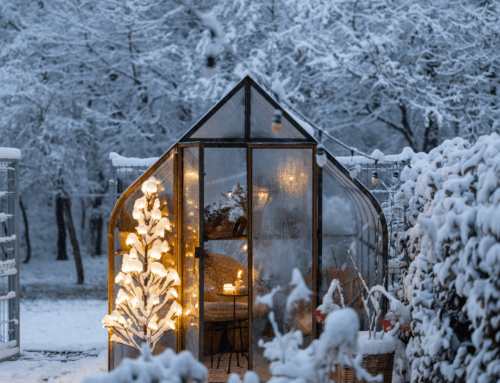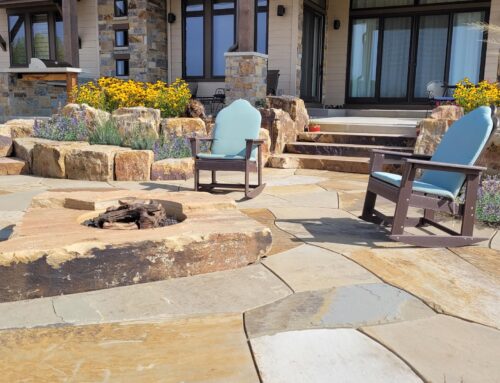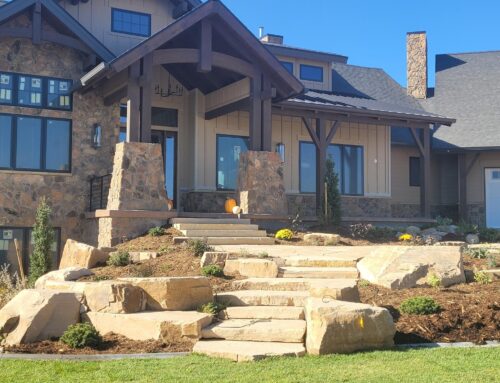When you think of a beautiful garden, it’s easy to imagine vibrant blooms in the spring and summer, or maybe the golden foliage of autumn. But in Colorado’s unpredictable climate, gardens often seem to take a backseat once winter arrives. The crisp air, snow-covered ground, and leafless trees might make your outdoor space feel dull and lifeless. However, with some careful planning and thoughtful design, you can create a four-season garden that offers beauty and interest year-round.

At Grounded Landscape Designs, we believe that every season has something special to offer in your landscape. By incorporating a variety of native plants and adding structure, you can turn your garden into a space that feels alive even in the coldest months. Let’s take a look at how you can enhance your landscape and keep it thriving through every season.
1. Start by Assessing Your Winter Landscape
Before making any changes, it’s important to look at your current garden with a critical eye—especially during the winter months when it’s easy to spot areas that lack color or interest. Take a stroll around your yard and note which areas feel empty or uninviting. Does the space look flat or uninspiring when the snow settles in? Are there any bare spots that seem to lack definition? If so, it might be time to think about how you can add more structure and greenery to keep things visually appealing even when the flowers are gone.
2. Evergreens: The Backbone of a Four-Season Garden
One of the easiest ways to create year-round interest in your landscape is by adding evergreens. These plants, which retain their foliage throughout the year, provide much-needed color and structure, particularly during the winter months when deciduous trees have shed their leaves.
With Colorado’s dry conditions, evergreens are an excellent choice because they are hardy and can withstand our dry winters and varying temperatures. Whether it’s the towering pines, the graceful junipers, or the dense spruces, these plants add a sense of permanence to your garden. Strategically place them throughout your yard—perhaps along the perimeter or as focal points in your garden beds—to provide structure and create natural windbreaks, which is especially important in our region’s gusty conditions.
In addition to conifers, consider incorporating a variety of evergreen shrubs like boxwoods, holly, and mountain laurels. These plants work well in foundation planting, adding texture and color while providing a backdrop for other seasonal plants. A landscape filled with different varieties of evergreens can provide a layered, dynamic effect that remains beautiful and functional through the cold months.
3. Add Structure with Hardscaping
While plants are essential, it’s also crucial to incorporate hardscaping elements to add definition and structure to your garden year-round. Hardscaping refers to the non-plant elements of your landscape, such as patios, walkways, retaining walls, and garden sculptures. These elements stay in place throughout the year and provide visual interest even when plants are dormant.
Consider adding a few key hardscaping features to complement your evergreen plantings. A stone pathway through your garden can guide the eye and create movement in your space. A low stone wall or a decorative trellis can frame your landscape and provide vertical interest. And if you have space, a fire pit or seating area can transform your backyard into a cozy winter retreat, where you can enjoy the outdoors even when the temperature drops.
Additionally, the use of mulch, gravel, or decorative stone can help prevent erosion and maintain the structure of garden beds during Colorado’s freeze-thaw cycles. By combining these hardscape elements with your evergreen plantings, you’ll create a garden that offers both visual appeal and practical benefits year-round.
4. Choose Winter-Interest Plants
While evergreens are the stars of the winter garden, other plants can also contribute to the season’s beauty. Winter-interest plants are those that maintain their appeal through the colder months, whether through striking bark, colorful stems, or seed heads. Many of these plants, such as drought-tolerant plants, are perfect for Colorado’s dry climate and soil conditions.
Consider adding plants like:
- Red-twig dogwood: The bright red stems of this shrub stand out beautifully against a snowy backdrop.
- Winterberry holly: This deciduous holly has vibrant red berries that persist throughout winter, adding a pop of color.
- Perennial grasses: Many ornamental grasses, such as blue fescue or feather reed grass, maintain their form throughout the winter, providing texture and movement even in the colder months.
Another great addition is ornamental trees with interesting bark, like the paperbark maple or the river birch. These trees peel away their bark in strips, revealing a striking cinnamon color that adds contrast and warmth to a winter landscape.
5. Design for Seasonal Transitions
As you plan your four-season garden, think about how your garden will transition from one season to the next. This could mean planning for early blooms in the spring, lush summer foliage, colorful autumn leaves, and a dynamic winter landscape.
Layer your plants so that when one variety fades, another takes over. Early-blooming bulbs like crocus and daffodils can bring color to your garden in early spring, while perennials like lavender and echinacea will keep things lively during the summer. By creating a balanced design that includes a mix of plants that bloom at different times, you’ll ensure that your garden never lacks color or interest throughout the year.
6. Consider the Microclimates in Your Yard
Colorado’s weather can change quickly, which means your garden may experience varying conditions depending on the location within your yard. Pay attention to the microclimates in your space—areas that are sheltered from the wind, or spots that receive more sun during the day. These areas will likely support different plant types than those in more exposed locations. Understanding these conditions will help you choose the right plants for each area of your garden, ensuring their success in both soil conditions and in offering beauty year-round.
7. Maintain Year-Round Care
Lastly, a four-season garden requires ongoing care to keep it looking its best year-round. Regular maintenance tasks such as pruning, cleaning, and mulching can help keep your garden in top shape and prevent damage during the winter months. For example, clearing snow from delicate branches can prevent them from snapping under the weight, and mulching around plant roots can provide insulation during cold spells.
Don’t Let Colorado’s Temperature Fluctuations Affect Your Garden
With a little planning and strategic plant selection, you can create a stunning four-season garden that thrives in Colorado’s ever-changing and dry climate. By incorporating evergreens, adding structure with hardscaping, and selecting plants with winter interest, you’ll create a landscape that offers beauty and functionality no matter the season. Whether you’re enhancing your current winter landscape or starting from scratch, Grounded Landscape Designs can help you craft the perfect outdoor space for year-round enjoyment.
Ready to start planning your four-season garden? Contact us today to get started on your next landscaping project!




